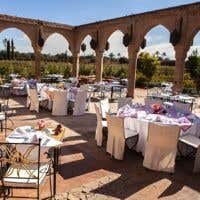This article was also published in the Financial Times.
It was the introduction to Paula Wolfert's book Good Food from Morocco, written 40 years ago, that pointed me in the right direction before a stay in Marrakech.
She enthusiastically outlines the country's four unmissable dishes: couscous, tagines, meshwi (slow-cooked lamb) and pastilla, the enveloping of chicken, pigeon or, increasingly, chocolate in thin layers of pastry.
Then Wolfert concisely lists the four reasons that lie behind this rich cuisine: a fertile countryside, the numerous cultural influences on Morocco's history, a great civilisation and, finally, a refined palace life, where royal patronage allowed cooks to take these dishes to the highest level.
Now I cannot vouch for the cooking at the royal court today, although on our first night we, and the king, were in close proximity. As our taxi driver approached one of the arches leading out of the medina, he was stopped by a policeman and re-directed as the royal entourage was close by.
We were on our way to the second branch of the Al Fassia Aguedal restaurant in one of the city's many new suburbs. My quest was for a pigeon pastilla, a dish I had been told was not that common as the relatively dry meat of the pigeon requires a level of culinary technique no longer widely found. Although the dish was there, there was no magic.
The restaurant is housed in a new building close to a giant Carrefour supermarket and lacks charm. The service was peremptory and one of the dishes, the renowned chicken tagine with preserved lemons and almonds, although correctly prepared, was so salty it was inedible. When we pointed this out to our waitress, we were greeted with a polite smile but it still appeared on our bill.
Dinner was, however, an introduction to the now vastly improved Moroccan wines. A bottle of Château Roslane 2008 Les Coteaux des Atlas was very good, as were subsequent bottles of Tandem Syrah 2008, made in conjunction with Rhône winemaker Alain Graillot, and the whites, reds, rosés and vins gris (very pale rosés) made at Domaine du Val d'Argan by another Frenchman, Charles Mélia.
Over the next two days I was to learn that as much as the ingredients and these distinctive dishes play a part in what can make eating out in Marrakech so memorable, what accentuates the pleasure even further is when this takes place in its truly distinctive settings.
This happened twice with meals at the very different Beldi Country Club (pictured above by Matt Humphrey), a fifteen-minute drive outside the city, and La Terrasse des Épices, two storeys above the main souk in the heart of the city.
Although physically very different, both share several charming features. The first is an uninterrupted view across to the snow-capped Atlas Mountains, an experience accentuated at the Country Club by the fields of fragrant roses that surround the restaurant. Both also thoughtfully provide pointed raffia hats as protection against the piercing early afternoon sun and both write their menus on blackboards that the waiters carry from table to table.
 Culinary highlights of the former included 'cigares', thin tubes of crisp pastry (and Moroccans really are wizards with flour and water, from their simple, invariably home-baked, round loaves to their pastries) filled with fresh tuna and melted cheese, and simply grilled quails with salt and fresh harissa, the spicy Moroccan condiment. Highlights at La Terrasse des Épices, a simple but popular rooftop café, were a sardine tart, a monkfish tagine and an individual serving of a meshwi.
Culinary highlights of the former included 'cigares', thin tubes of crisp pastry (and Moroccans really are wizards with flour and water, from their simple, invariably home-baked, round loaves to their pastries) filled with fresh tuna and melted cheese, and simply grilled quails with salt and fresh harissa, the spicy Moroccan condiment. Highlights at La Terrasse des Épices, a simple but popular rooftop café, were a sardine tart, a monkfish tagine and an individual serving of a meshwi. Each meal also brought an insight into the Moroccan approach to hospitality.
At the Beldi Country Club, our young manager was so delighted to see an old customer return for lunch that he embraced him warmly and then buried his face in the guest's shoulder to reinforce this sentiment.
On the crowded Riad Zitoune El-Kedim shop-lined pathway that led out of the souk and back to our riad, we were stopped twice. On the first occasion I was importuned to go upstairs to eat on the restaurant's patio as 'my pale English face obviously needed some Moroccan sunshine'. A couple of hundred yards further on, I was told that our 21-year-old daughter was so beautiful that if we were to go and eat in this restaurant, there would obviously be no charge for her meal. I cannot see either of these tactics being followed in London, Paris or New York.
We braved this street again that night, skirted the famous Place Djemma El-Fna, pausing of course to take in the snake charmers, storytellers and musicians, and plunged into the souk again, this time on the advice of Stephanie Chaudy, châtelaine of the beautifully restored Riad Karma. Our destination was the restaurant Villa Flore, another example of the Frenc⁞h influence that is still so strong here.
While the entrance off the souk is unreconstructed, Parisian architect Jacques Gering and his wife Martine have created over what was a rubbish heap a stylish set of rooms with an equally stylish menu. Highlights included harira, the thick pungent soup served with dates; pigeon pastilla, here served as three small 'cigares'; and couscous with lamb, pears and cinnamon – this time perfectly seasoned.
Al Fassia Aguedal www.alfassia-aguedal.com
Beldi Country Club www.beldicountryclub.com
La Terrasse des Épices www.terrassedesepices.com
Riad Dar Karma www.dar-karma.com
Villa Flore www.villa-flore.com

